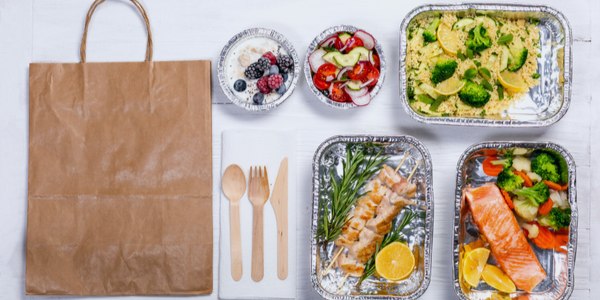
What is a low fiber diet? What is a low residue diet? When considering a low fiber diet or low fiber foods, it is important to understand when it is indicated.
Read on to learn everything there is to know about low-fiber or low-residue diets.
What Is a Low-Fiber Diet?
Dietary fiber in adequate amounts is recommended for many health reasons. Heart health, digestive health, and weight loss overall benefit from fiber in the diet.
However, in special cases, low-fiber diets are prescribed by health professionals. Low-fiber diets can help people adjust their digestion after diagnosis, surgery, or other therapies and treatments.
Eating a diet low in fiber helps to limit bowel movements. Abdominal symptoms, conditions, or pain can cause diarrhea and other digestive discomforts. Digestive symptoms can be eased in many cases by temporarily decreasing high-fiber foods.
Is Low Residue the Same As Low Fiber?
A low-fiber diet is often referred to as a "low-residue" diet. Residue is a term that means undigested food. Fiber leaves residue in the digestive tract that adds substance to the stool.
Fiber is found in fruits, vegetables, and grains. It is not digested by the body. Instead, it passes through the large intestine leaving residues and ultimately bulking up the stool.
When Is a Low Fiber Diet Recommended?
According to the most recent dietary guidelines, Americans generally are not getting enough fiber. However, certain individuals can experience benefits from being on a low-fiber diet.
The following diagnoses may warrant a low-fiber diet:
• Inflammatory bowel disease (IBD)
• Crohn's disease
• Ulcerative colitis
• Diverticulitis
When managing IBD or other digestive diseases, monitoring fiber intake can ease pain. Lowering fiber levels in the diet can alleviate symptoms. Other reasons to consider a low-fiber diet include:
• Surgery (especially bowel surgery)
• Chemotherapy
• Radiation (can damage or irritate the digestive tract)
• Narrowing of the bowel (i.e. tumor, inflammatory disease)
As the digestive tract returns to normal, it is usually appropriate to slowly add more fiber back into the diet.
Is A Low Fiber Diet Healthy?
With the guidance of a dietitian, an adequately balanced low-fiber diet can be properly planned. A dietitian can also help to adjust a low-fiber diet to specific needs or allergies.
For example, milk does not contain fiber but can cause diarrhea or discomfort. This is especially true of those with lactose intolerance. A dietitian can help to manage symptoms and shift dietary plans when necessary.
What Can You Eat In a Low Fiber Diet?
The preparation of foods is just as important as the type of food when it comes to low-fiber diets. Before discussing ingredients, it is important to understand good cooking methods, which include:
• Simmering
• Poaching
• Stewing
• Steaming
• Braising
• Baking or microwaving in a covered dish
These cooking methods help to make the food more palatable. Drinking plenty of water is also important. Eating well-cooked foods and drinking adequate fluids help to avoid constipation.
Instead of high-fiber foods, consider these low-fiber diet options:
• Soft, canned, and well-cooked vegetables (i.e. green beans, carrots, spinach)
• Plain tomato sauce
• Vegetable or fruit juices
• Peeled or well-cooked potatoes
• Soft applesauce
• Canned peaches and pears (without skin)
• Ripe bananas
• Soft cantaloupes and melons
• Ground, tender meats or lunch meat
• Lean fish and shellfish
• Poultry
• Eggs
• Tofu
• Smooth peanut butter
• Butter, margarine, oils, or salad dressings without seeds
• Mild seasonings
While white grain products are generally stripped of nutrients, they offer a low-fiber alternative. When in doubt, pick hot or cold cereals that have less than 2 grams of fiber per single serving.
Other options for grains include:
• Cooked cereals (i.e. cream of wheat)
• Cold cereals (i.e. puffed rice, corn flakes)
• White rice
• White pasta noodles
• Baked goods made with refined wheat or rye flour (i.e. white bread, biscuits, pancakes, waffles, bagels)
• Crackers made from refined flour (i.e. saltines)
Foods with lactose can sometimes pose a problem for the digestion-impaired. Try these options instead:
• Almond milk
• Cashew milk
• Lactose-free alternatives
• Soy milk
What Foods To Avoid On a Low Fiber Diet
High-fiber foods, such as the following, should be swapped for more gentle-to-digest, cooked, or refined foods:
• Grains (i.e. whole grains, brown rice, oatmeal, granola)
• Kasha (buckwheat)
• Cornbread or cornmeal
• Bran
• Wheat germ
• Beans (i.e. baked beans, lentils)
• Legumes and peas
• Nuts (i.e chunky peanut butter)
• Seeds
• Breads with added seeds
• Raw or dried fruits and vegetables (i.e. fresh apple, coconut)
Other foods or food components to be mindful of and avoid include:
• Berries with seeds
• Prunes, prune juice, and raisins
• Marmalade
• Tomatoes (also contain seeds)
• Cabbage, broccoli, cauliflower, Brussels sprouts, greens
• Pickles, olives, relish, and horseradish
• Sauerkraut
• Onions
• Lactose (i.e. milk and dairy)
• Milk alternatives (may contain small amounts of fiber)
• Processed meats (i.e. hot dogs, sausage, cold cuts)
• Popcorn
• Potato chips
Meat products are generally absent of fiber. However, meats can be tough and fibrous in texture. Be sure to opt for ground or lean meats. Fatty meats can also increase the bulkiness of stools, so it is safest to avoid those.
The Recap on Low-Fiber Diets
Even though many Americans get less fiber than they should, people with digestive discomfort can benefit from a low-fiber diet. Another name for low-fiber diets is low-residue diets, and they can help alleviate abdominal pain.
By knowing which foods to eat and which foods to avoid, one can successfully navigate surgery, inflammatory bowel conditions, and even more.
References:
American Cancer Society. Low-Fiber Foods. American Cancer Society. Published May 5, 2020. https://www.cancer.org/treatment/survivorship-during-and-after-treatment/staying-active/nutrition/low-fiber-foods.html.
Mayo Clinic Staff. Nutrition and healthy eating. Mayo Clinic. Published December 5, 2020. https://www.mayoclinic.org/healthy-lifestyle/nutrition-and-healthy-eating/in-depth/low-fiber-diet/art-20048511.







